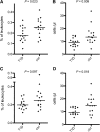Altered phenotype of peripheral blood dendritic cells in pediatric type 1 diabetes
- PMID: 22787171
- PMCID: PMC3476907
- DOI: 10.2337/dc11-2460
Altered phenotype of peripheral blood dendritic cells in pediatric type 1 diabetes
Abstract
Objective: Dendritic cells (DCs) are largely responsible for the activation and fine-tuning of T-cell responses. Altered numbers of blood DCs have been reported in type 1 diabetes (T1D). We aimed at characterizing the less well-known phenotypic properties of DCs in T1D.
Research design and methods: In a case-control setting, samples from a total of 90 children were studied by flow cytometry or by quantitative real-time PCR (qPCR).
Results: We found decreased numbers of myeloid DCs (mDCs) (8.97 vs. 13.4 cells/μL, P = 0.009, n = 31) and plasmacytoid DCs (pDCs) (9.47 vs. 14.6 cells/μL, P = 0.018, n = 30) in recent-onset T1D. Using a panel of antibodies against functionally important DC markers, we detected a decreased expression of CC chemokine receptor 2 (CCR2) on mDCs (percentage above negative control, P = 0.002, n = 29) and pDCs (median intensity, P = 0.003, n = 30) from T1D patients. In an independent series of children, the reduced expression of CCR2 was confirmed by qPCR in isolated mDCs (P = 0.043, n = 20). Serum concentrations of CCR2 ligands monocyte chemotactic protein-1 and -3 did not differ between the groups. A trend for an enhanced responsiveness of the nuclear factor-κB pathway (P = 0.063, n = 39) was seen in mDCs from children with β-cell autoantibodies, which is possibly related to the reduced CCR2 expression, since CCR2 on mDCs was downregulated by nuclear factor-κB-activating agents.
Conclusions: Given the role of CCR2 in DC chemotaxis and in DC-elicited Th1 differentiation, our results may indicate a functionally important DC abnormality in T1D affecting the initiation and quality of immune responses.
Figures



References
-
- Lehuen A, Diana J, Zaccone P, Cooke A. Immune cell crosstalk in type 1 diabetes. Nat Rev Immunol 2010;10:501–513 - PubMed
Publication types
MeSH terms
LinkOut - more resources
Full Text Sources
Medical
Research Materials

